Robert Bosch Car Multimedia 52R0 Car radio & infotainment system User Manual Part 6
Robert Bosch Car Multimedia GmbH Car radio & infotainment system Users Manual Part 6
Contents
Users Manual_Part 6
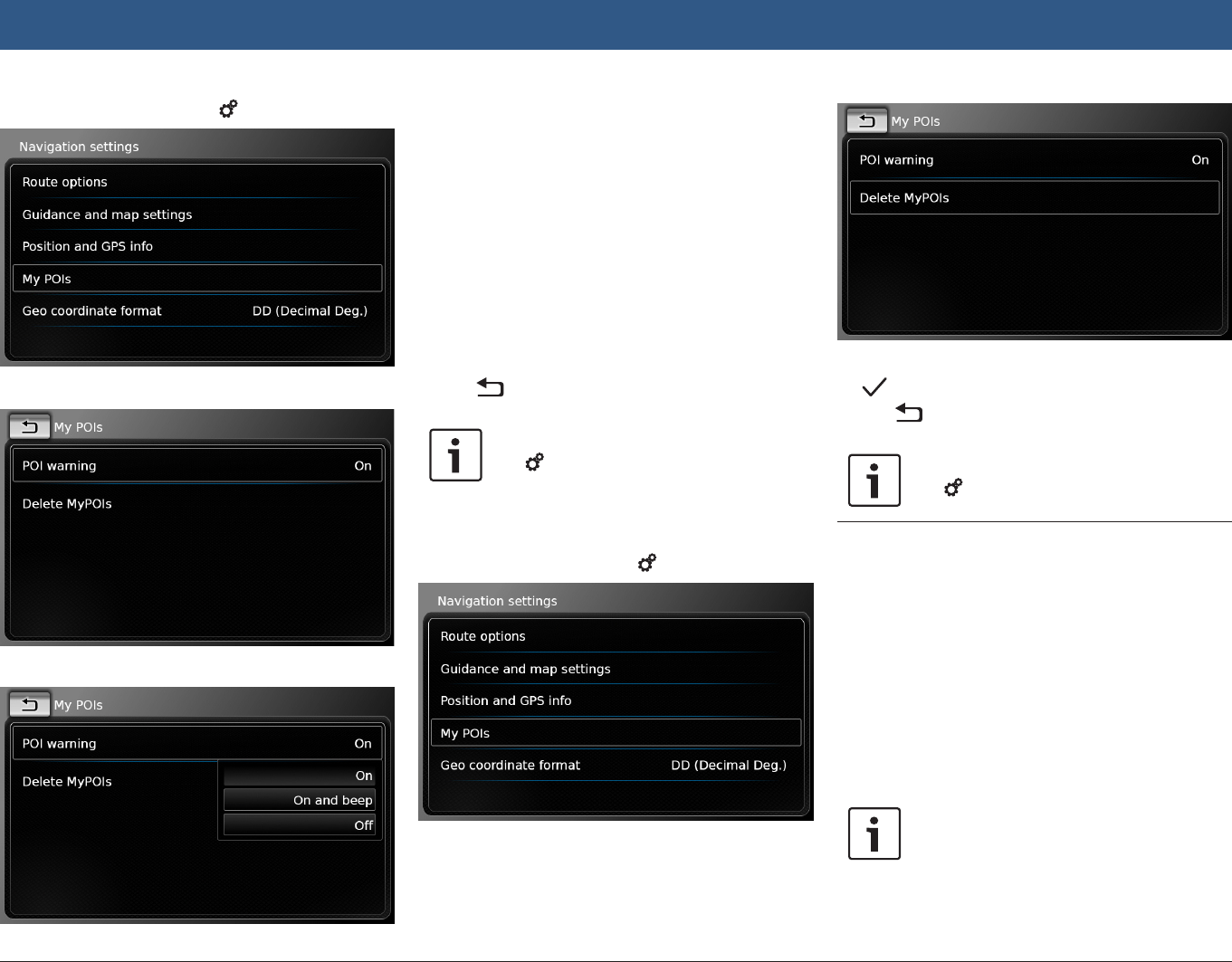
54 | en
fIn navigation mode, tap 6.
fTap My POIs.
fTap POI warning.
fTap the relevant option:
fOn:
The system issues the point of interest
warning by displaying a symbol.
fOn and beep:
The system issues the point of interest
warning by displaying a symbol and mak-
ing a beep sound.
fOff:
No point of interest warning is issued.
fTap .
Note:
Tap 6 to close the options display.
8.12.4 Deleting your own points of
interest from the device
fIn navigation mode, tap 6.
fTap My POIs.
fTap Delete MyPOIs and confirm by tapping
.
fTap .
Note:
Tap 6 to close the options display.
8.13 Enabling the keypad lock while
driving
You can set the keypad lock in the system set-
tings.
If the Lock keypad while driving setting is ena-
bled, you will only be able to access the keypad
while the vehicle is stationary.
For further details on this, please read the sec-
tion entitled “Enabling the keypad lock while
driving” (page 15).
Note:
When the Lock keypad while driving
setting is enabled, certain features of
the device’s navigation and smart-
Navigation
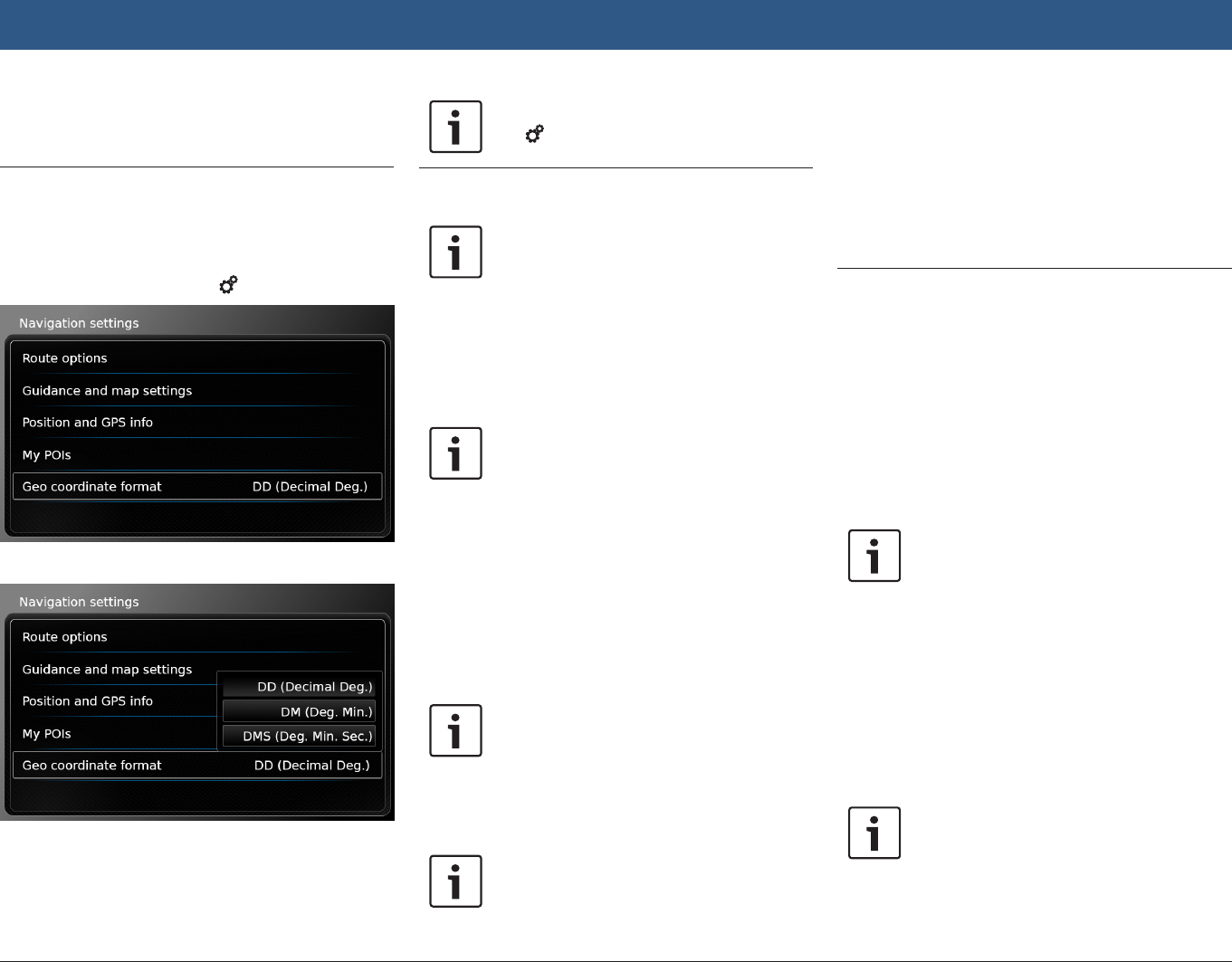
en | 55
phone integration functions are disa-
bled to avoid driver distraction.
8.14 Selecting the geo coordinate
format
You can set the format in which geo coordinates
are specified.
fIn navigation mode, tap 6.
fTap Geo coordinate format.
fTap the relevant option:
fDD: Decimal degrees
fDM: Degrees and minutes
fDMS: Degrees, minutes and seconds
Note:
Tap 6 to close the options display.
8.15 Updating the map data
Note:
For information about map data
updates please refer to
www.suzuki-slda.com.
You can update the map data by loading new
map data onto the device from an SD card.
Note:
For details on handling SD cards,
please read the section entitled “Con-
necting/inserting external devices and
data storage devices” (page 23).
fInsert the SD card containing the map data
into the SD card slot 3.
The compatibility of the map data is checked
and confirmed.
Note:
If the map data is incompatible, the
device will not respond.
The map data is loaded onto the device.
Notes:
fPlease do not remove the SD card
from the device. If the SD card
containing the navigation system’s
map data is removed, you will not be
able to use the navigation function.
fIf the map data was not loaded
successfully, please contact your
Suzuki dealer.
8.16 Retrofitting the navigation func-
tion
If the device is not originally equipped with the
navigation function, it may be possible for you to
have it retrofitted. Please contact your Suzuki
dealer regarding this.
The navigation software for your device is sup-
plied on an SD card. Please follow the instruc-
tions below to install the navigation software:
Note:
For details on handling SD cards,
please read the section entitled “Con-
necting/inserting external devices and
data storage devices” (page 23).
fInsert the SD card containing the navigation
software into the SD card slot 3.
The compatibility of the navigation software is
checked and confirmed.
Note:
If the navigation software is incompat-
ible, the device will not respond.
Navigation
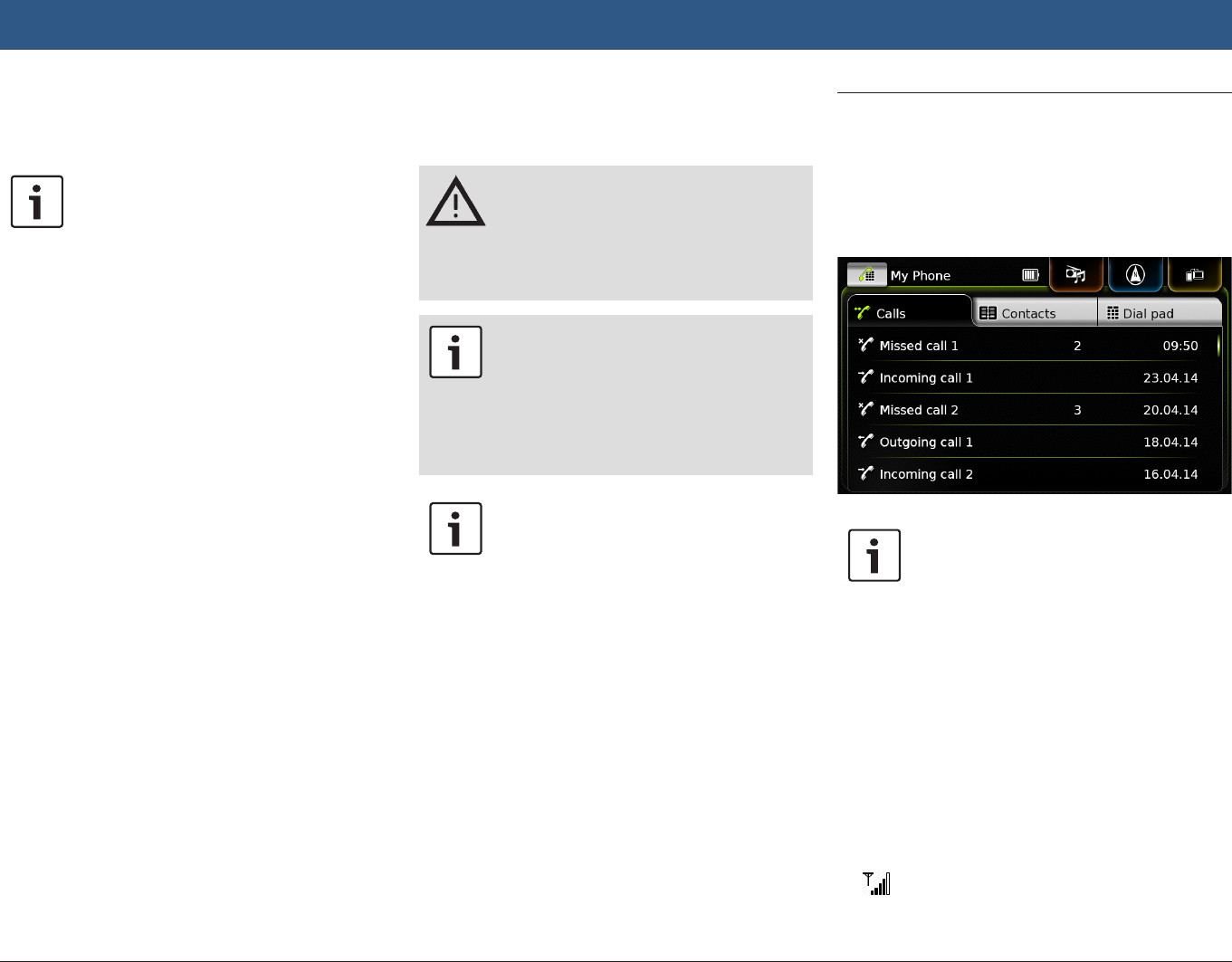
56 | en
The navigation software is loaded onto the
device.
Note:
If the navigation software was not
loaded successfully, the device will
restart without the navigation function.
In this case, please try again. If the
problem persists, please contact your
Suzuki dealer.
9 Telephone
Road safety
Using the hands-free facility while
driving can be dangerous, since your
attention is reduced during a telephone
conversation.
Important note:
Ensure that you follow the regulations
in areas where there might be a risk
because of interference by the mobile
phone or a risk of a dangerous situa-
tion.
Notes:
fTo connect a mobile phone via
Bluetooth®, please refer to the
section entitled “Connecting/insert-
ing external devices and data stor-
age devices” (page 23).
fYour mobile phone may not support
all the hands-free phone features
that are provided by the device.
9.1 Starting phone mode
9.1.1 Opening the phone menu
To open the phone menu,
ftap the Call area in the Home menu.
The phone menu is displayed:
Notes:
fIf provided by your mobile phone,
the Calls list will show the number
or contact name of the caller.
fIf no mobile phone is connected,
the Select Bluetooth device menu is
displayed. For more information
about the Select Bluetooth device
menu, please refer to the section
entitled “Opening the Select Blue-
tooth device menu” (page 26).
The phone status is displayed beside the name
of the connected mobile phone at the top:
f : Reception (signal strength)
Navigation | Telephone
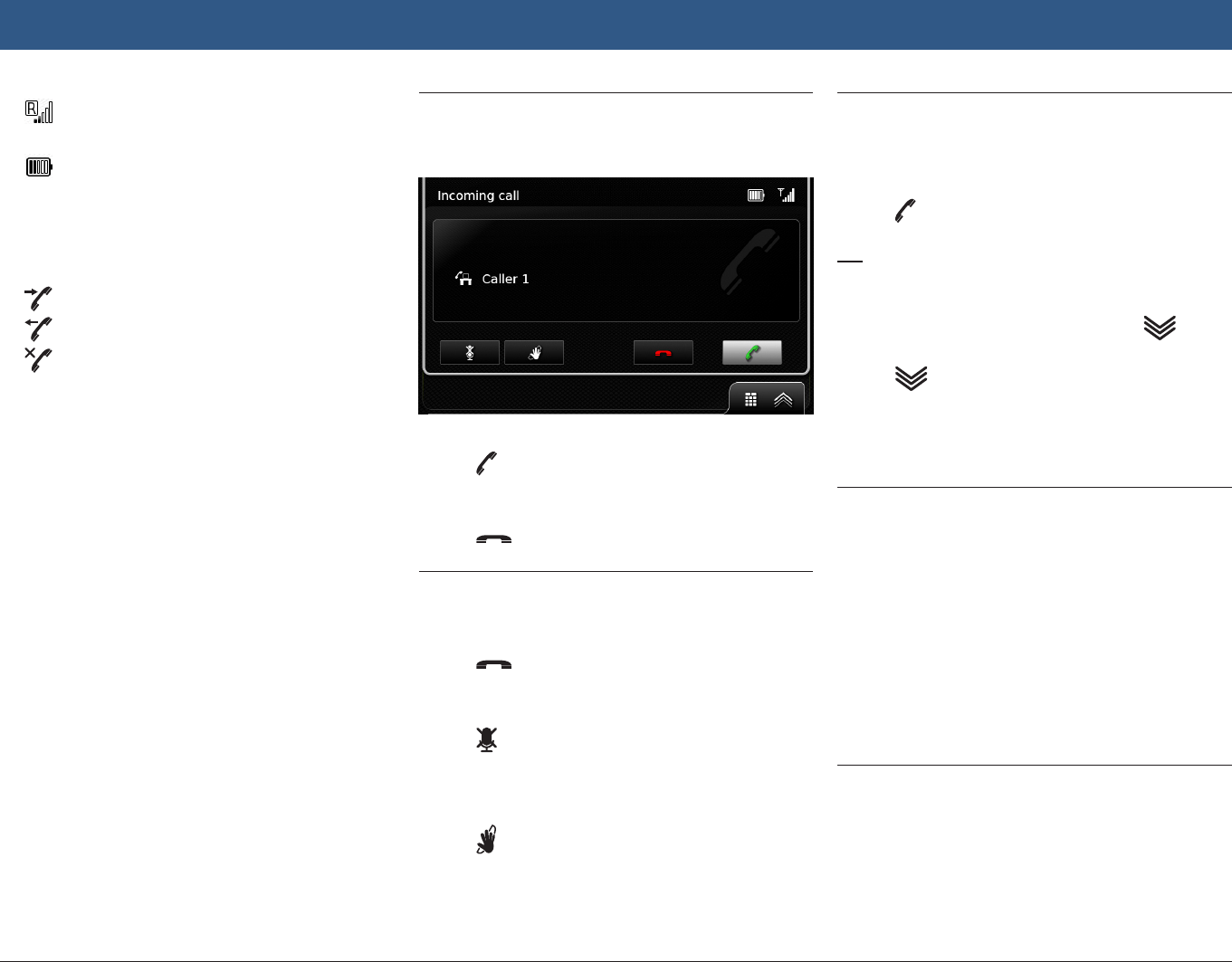
en | 57
f : Roaming (when you are in a roaming
area)
f : The low battery status will be displayed
on screen when the connected phone’s bat-
tery charge is low.
Under the Calls tab, the list of calls is displayed:
f: Incoming calls
f: Outgoing calls
f: Missed calls
For each call, the time or date is displayed.
In the case of missed calls, the number of con-
nection attempts is displayed in front of the
time/date.
For more information about the Calls menu,
please refer to the section entitled “Calling an
entry in the call list” (page 57).
When you switch to the Contacts tab, you can
call the number of a stored contact.
Please refer to the section entitled “Calling a
contact from the phone book” (page 57).
When you switch to the Dial pad tab, you can
dial a number.
Please refer to the section entitled “Dialling a
number” (page 57).
9.2 Answering/rejecting a call
This notification appears when you receive an
incoming call:
9.2.1 Answering a call
fTap .
9.2.2 Rejecting a call
fTap .
9.3 During the current call
9.3.1 Ending the call
fTap .
9.3.2 Muting the call
fTap .
9.3.3 Switching the call to the
mobile phone
fTap .
9.4 Dialling a number
fIn the phone menu, tap the Dial pad tab, if
necessary.
fEnter the number.
fTap to call the number you entered.
Or:
fEnter the first digits of the number.
The number of matches corresponding to the
entered digits is displayed beside the sym-
bol.
fTap to display the numbers from your
contacts that match what you have entered.
fTap the desired number.
The selected number is called.
9.5 Calling a contact from the
phone book
fIn the phone menu, tap the Contacts tab, if
necessary.
fTap the desired contact.
If there are several numbers of equal priority
stored for the contact, all these numbers will be
displayed.
fTap the desired number.
The number is called.
9.6 Calling an entry in the call list
The call list stores the numbers that have been
dialled and the numbers of received calls.
Telephone
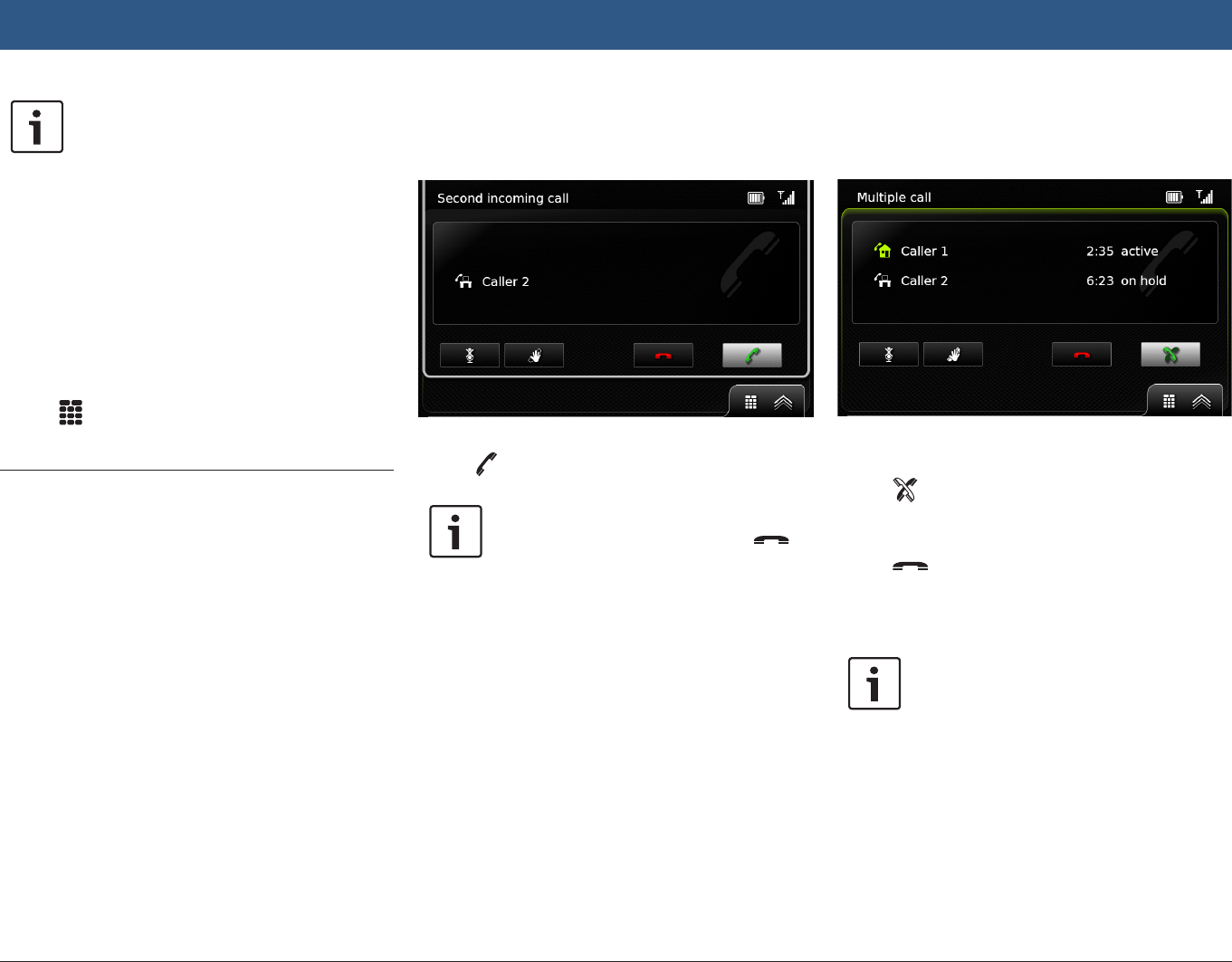
58 | en
Note:
A maximum of 60 items are stored in
the call list.
fIn the phone menu, tap the Calls tab, if nec-
essary.
fTap the desired number.
The number is called.
9.6.1 Tone dial feature (DTMF)
During a current call, you can generate DTMF
tones:
fTap .
fEnter a number.
9.7 Second call
You can manage two calls simultaneously if you
answer another call during your current call.
9.7.1 A second incoming call
If you receive a second call during your current
call, the following notification appears:
fTap to answer the second call.
Notes:
fTo reject the second call, tap .
fIf you answer the second call, your
current call is automatically inter-
rupted and the connection put on
hold.
9.7.2 Switching between two calls
If there are two simultaneous calls, the following
display appears:
To switch between the two calls,
ftap .
To end the currently active call,
ftap .
The call that is on hold will be activated auto-
matically.
Note:
Even if the person you are calling ends
the active call, the call that is on hold
will be activated automatically.
Telephone
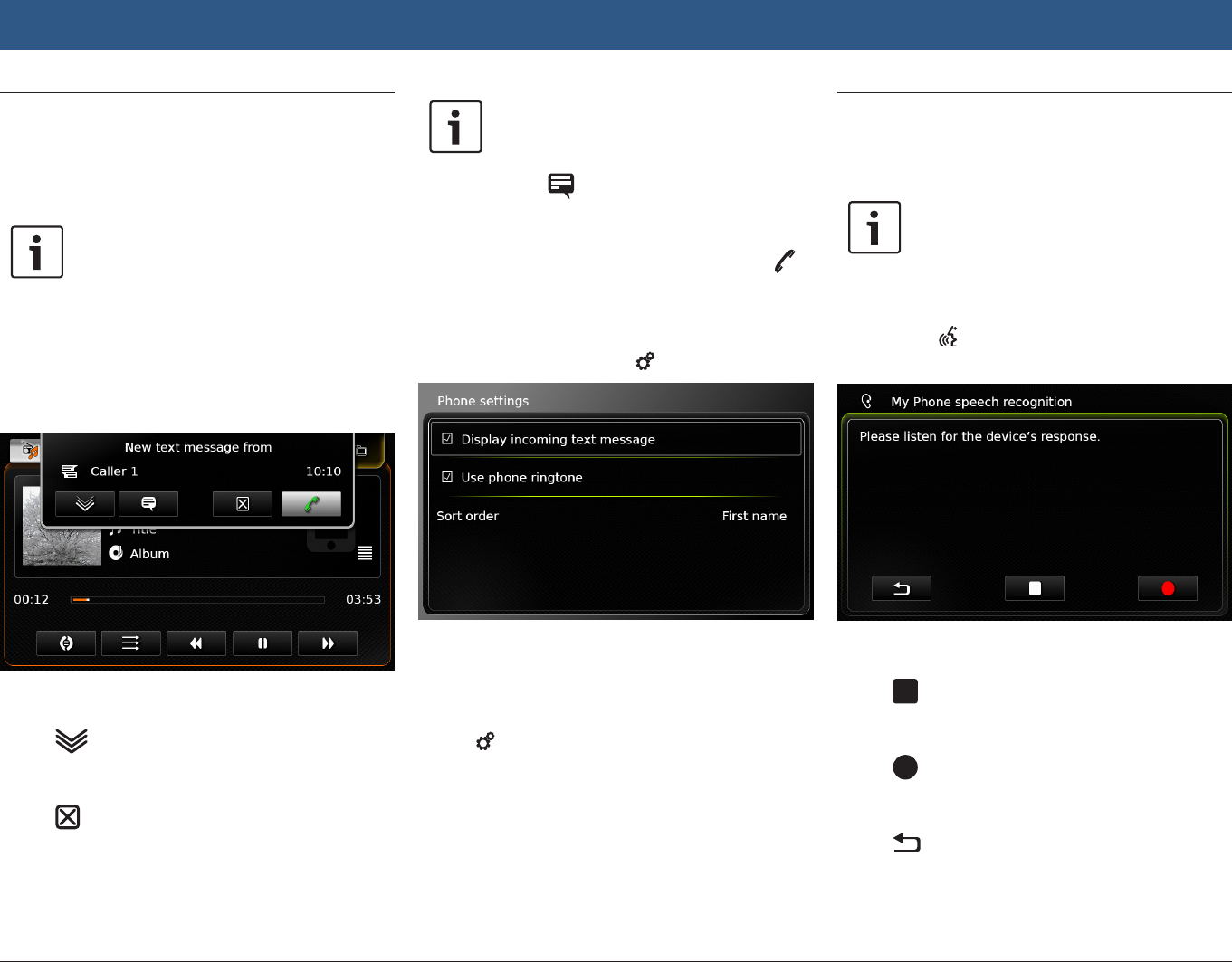
en | 59
9.8 SMS text messages
9.8.1 Reading an incoming text
message
Note:
You can enable or disable the display-
ing of incoming text messages. For
further details on this, please read the
following section.
The following notification appears when an
incoming text message arrives:
To display the text message,
ftap .
The text message is displayed.
To close the text message,
ftap .
Notes:
fIf you wish, you can have the system
read the message aloud. To do so,
tap . Please note that this func-
tion is not available in all system
languages.
fTo call the message sender, tap .
9.8.2 Incoming text message dis-
play – on/off
fIn telephone mode, tap 6.
fTap Display incoming text message.
Displaying of incoming text messages is enabled
when the check mark is displayed in the check-
box.
fTap 6 to close the menu.
9.9 Activating the voice control
system of the connected mobile
phone
Note:
This function is only available if the
connected mobile phone supports
voice control.
fLong-tap 5.
The speech recognition screen is displayed:
To stop the active voice control session,
ftap .
To active a new voice control session,
ftap .
To exit voice control,
ftap .
Telephone
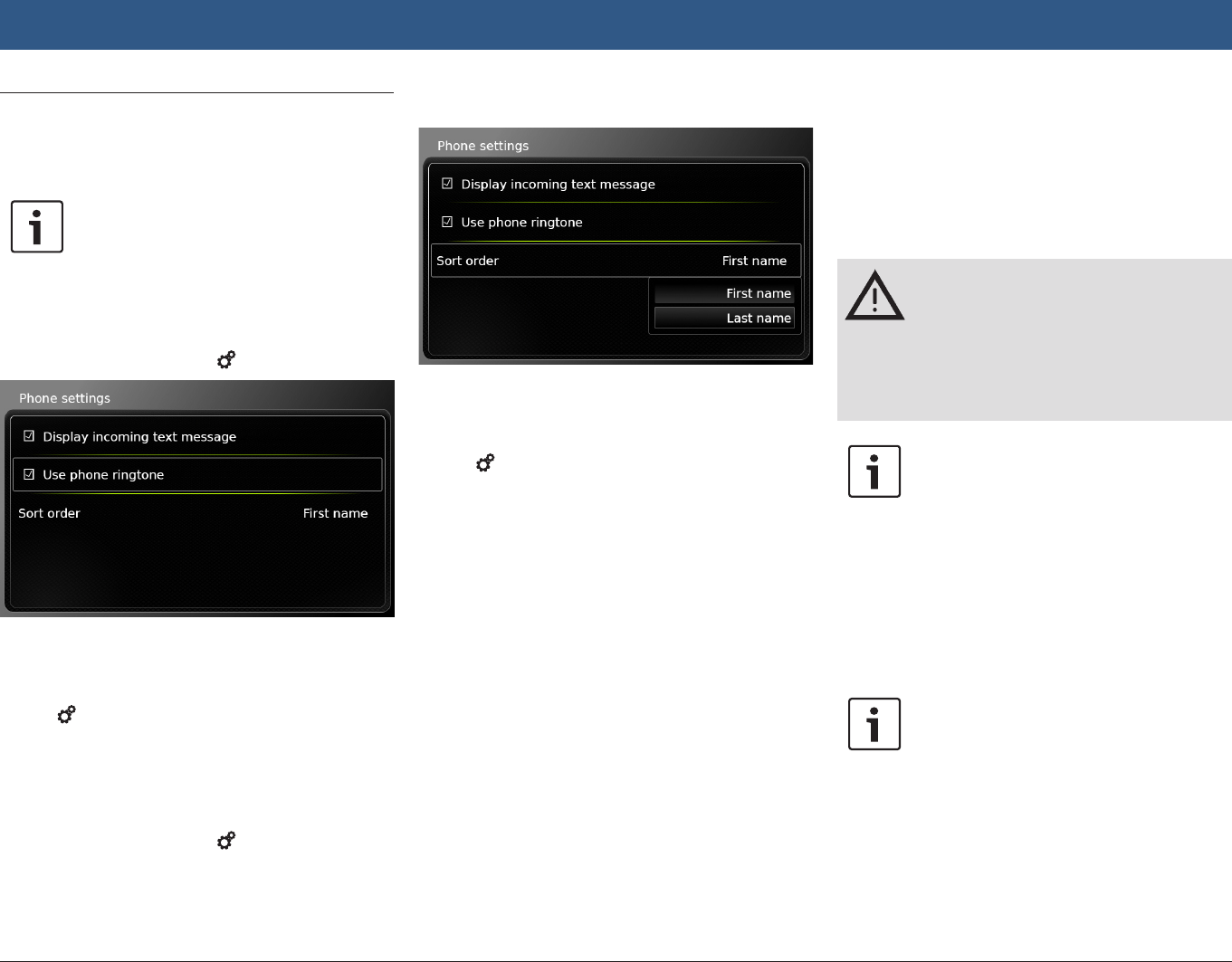
60 | en
9.10 Further settings
9.10.1 Ringtone of the mobile phone
Note:
This function is only available if the
connected mobile phone supports it.
For incoming calls, you can also use the ringtone
of your mobile phone.
fIn telephone mode, tap 6.
fTap Use phone ringtone.
Your mobile phone’s ringtone is used when the
check mark is displayed in the checkbox.
fTap 6 to close the menu.
9.10.2 Phone-book sort order
You can select the order in which the phone-
book entries are displayed.
fIn telephone mode, tap 6.
The telephone settings are displayed.
fTap Sort order.
fTap the desired option, First name or Last
name.
fTap 6 to close the menu.
10 Smartphone integra-
tion
You can connect a smartphone to the device via
Apple CarPlay, MirrorLink™ or Android Auto™.
Road safety
Using smartphone applications while
driving can be dangerous, since your
attention is reduced.
Park your vehicle before you use smart-
phone applications.
Note:
The phone charging level may not
progress as expected, depending on
the Android Auto functions that are
activated and how often they are used.
In some cases, if several features are
activated simultaneously and draw a
significant amount of current, the
charge level may even decrease.
Notes:
fInformation about which smart-
phones the device supports is avail-
able at www.suzuki-slda.com.
fTo connect a smartphone via smart-
phone integration, please read the
section entitled “Connecting a
smartphone via smartphone inte-
gration” (page 27).
Telephone | Smartphone integration
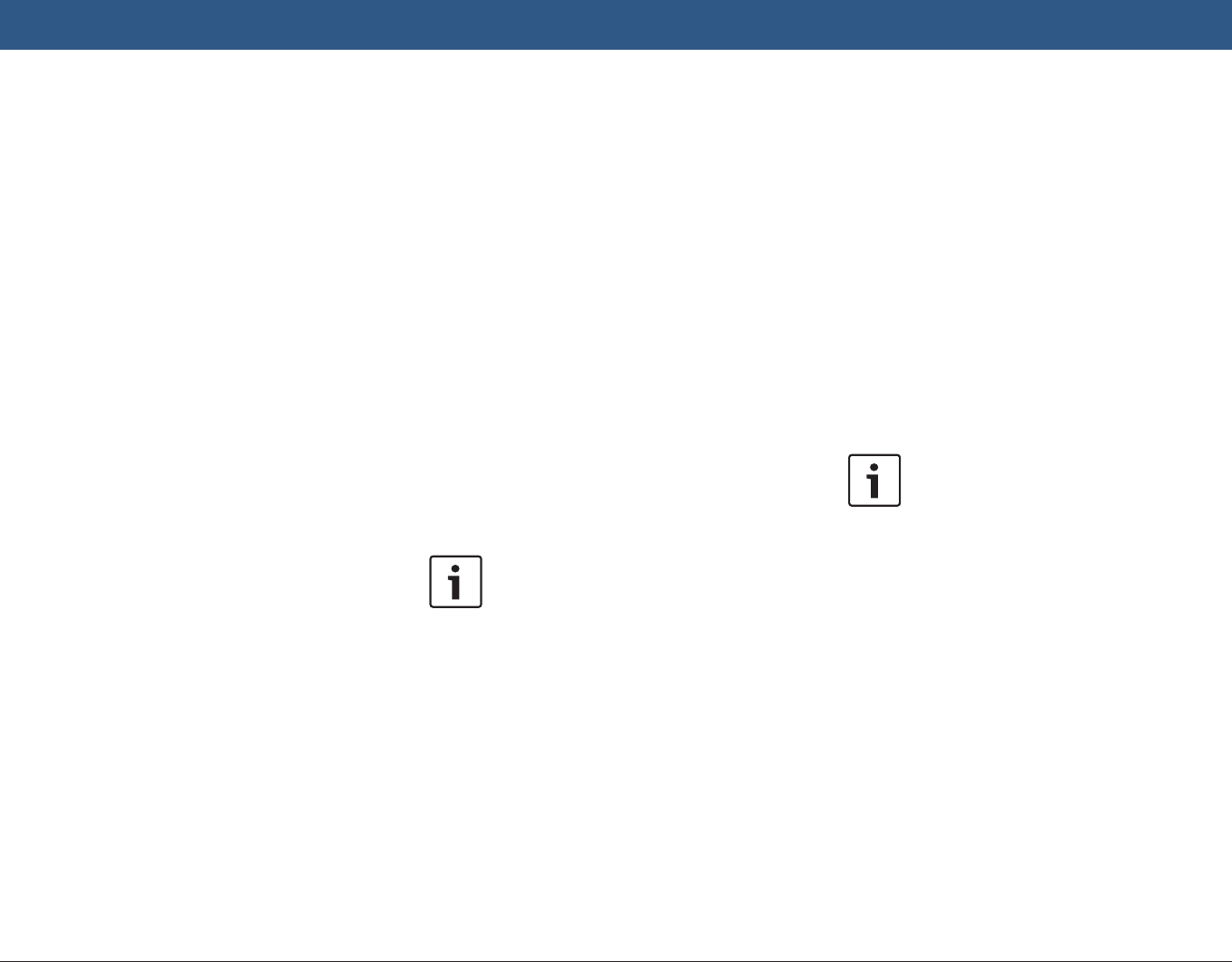
en | 61
fPlease visit Apple’s website to learn
more about features available for
CarPlay:
http://www.apple.com/ios/carplay/
fThe local availability of Apple Car-
Play depends on the support of
Apple. Information about the local
availability of Apple CarPlay is avail-
able at:
http://www.apple.com/ios/feature-
availability/#applecarplay-
applecarplay
fIf you connect an Apple iPhone via
smartphone integration, you will not
be able to select iPod as a media
source.
fApple CarPlay uses the Siri applica-
tion, for which internet connectivity
is necessary. Performance may vary
depending on data connectivity.
fPlease visit Google’s website to
learn more about the features avail-
able for Android Auto:
http://www.android.com/auto/
fInformation about the local availabil-
ity of Android Auto is available at
http://www.android.com/auto/.
Most features will not work if you
use Android Auto in a country where
it is not currently available.
fYou can use the talk to Google func-
tion to control Android Auto through
voice commands – internet connec-
tivity is required for this. Perfor-
mance may vary depending on data
connectivity.
fThe smartphone manufacturers are
responsible for the content and
functions of smartphone applica-
tions. The device merely provides
the option to display and operate
these applications.
fFor information on using smart-
phone applications on your smart-
phone, please read your smart-
phone’s instruction manual.
fFor safety reasons, you cannot
access some applications while the
vehicle is moving.
Notes about Apple CarPlay
features:
fTelephone functions:
To use a connected iPhone for tele-
phoning, use the telephone app of
your iPhone. The device’s telephone
functions are not available. If you try
to access the device’s telephone
functions, you will be automatically
redirected to the telephone app of
your iPhone.
fNavigation functions:
You can only use one navigation
system at a time. If you start a navi-
gation app on your iPhone and there
is a route guidance session already
active on the device’s navigation
system, that route guidance session
will be cancelled automatically (and
vice versa).
fAudio output:
The audio output of the connected
iPhone (such as announcements
from a navigation app) will be mixed
with the current audio output of the
device (such as currently playing
media).
Notes about MirrorLink™ fea-
tures:
fTelephone functions:
If the connected smartphone is not
connected via Bluetooth® too, you
will not be able to use the device as
a hands-free set. In this case, audio
input and output happens via the
speaker and microphone of your
smartphone.
fAudio output:
– The audio output of the con-
nected smartphone (such as
announcements from a naviga-
tion app) will be mixed with the
current audio output of the
device (such as currently playing
media).
Smartphone integration
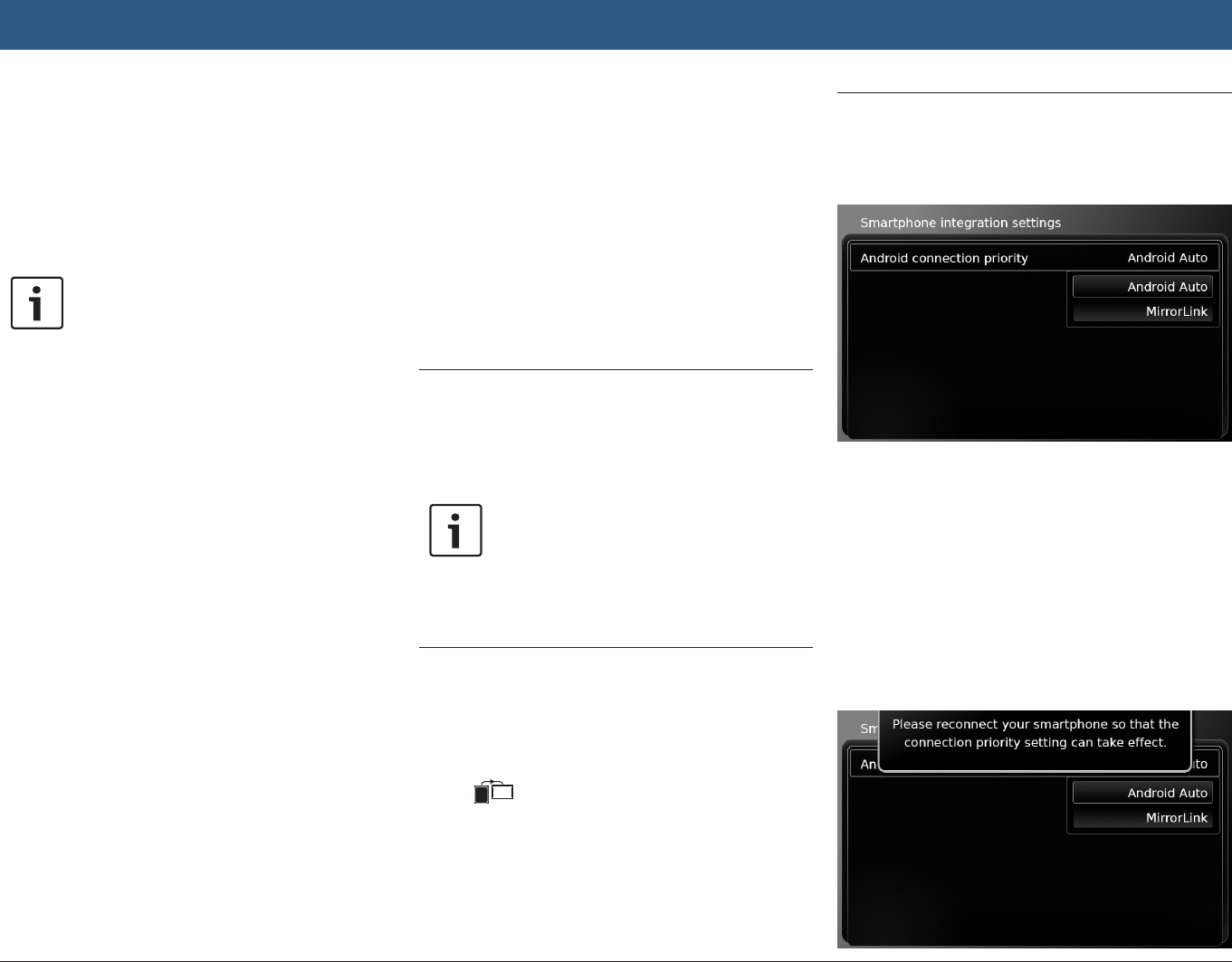
62 | en
– When connected via Mirror-
Link™, the Bluetooth® audio
player feature may not be avail-
able; in this case, please use the
MirrorLink™ audio player
instead.
Notes about Android Auto™
features:
fTelephone functions:
If the smartphone is connected via
the USB port but not via Bluetooth®,
you will not be able to use the
device as a hands-free set. In this
case, audio input and output take
place via the speaker and micro-
phone of your smartphone. For
telephony features like calling and
SMS, the smartphone needs to be
paired via Bluetooth®.
fNavigation functions:
You can only use one navigation
system at a time. If you start using
Android Auto navigation on your
smartphone and a route guidance
session is already active on the
device’s navigation system, that
active route guidance session will
be cancelled automatically (and vice
versa).
fAudio output:
The audio output of the connected
smartphone (e.g. announcements
from a navigation app) will be audi-
ble at a higher volume, and the
current audio output of the device
(e.g. currently playing media) will
be heard at a lower volume. When
connected via Android Auto, the
Bluetooth® audio player feature will
not be available; in this case, please
use the Android Auto audio player
instead.
10.1 Calling up the smartphone dis-
play
fTap the Connect area in the Home menu.
Your smartphone’s user interface is displayed.
Note:
Certain types of smartphones may
provide various compatible applica-
tions. For further details on this, please
read the next section.
10.2 Selecting a particular applica-
tion on a smartphone
Certain types of smartphones may provide
various compatible applications.
To select an application,
ftap in the Home menu.
The list of compatible applications is displayed.
fTap the desired application.
The selected application’s user interface is
displayed.
10.3 Smartphone integration set-
tings
Selecting an item in the smartphone integration
settings list will activate the respective feature.
10.3.1 Android™ connection priority
Android connection priority is used if a smart-
phone supports both Android Auto and Mirror-
Link™. If this is the case, the user has complete
freedom to choose which feature they would like
to use. The user can select the respective fea-
ture and will then be shown a pop-up notifica-
tion that asks them to reconnect the smart-
phone via USB in order to use the selected
feature.
Smartphone integration
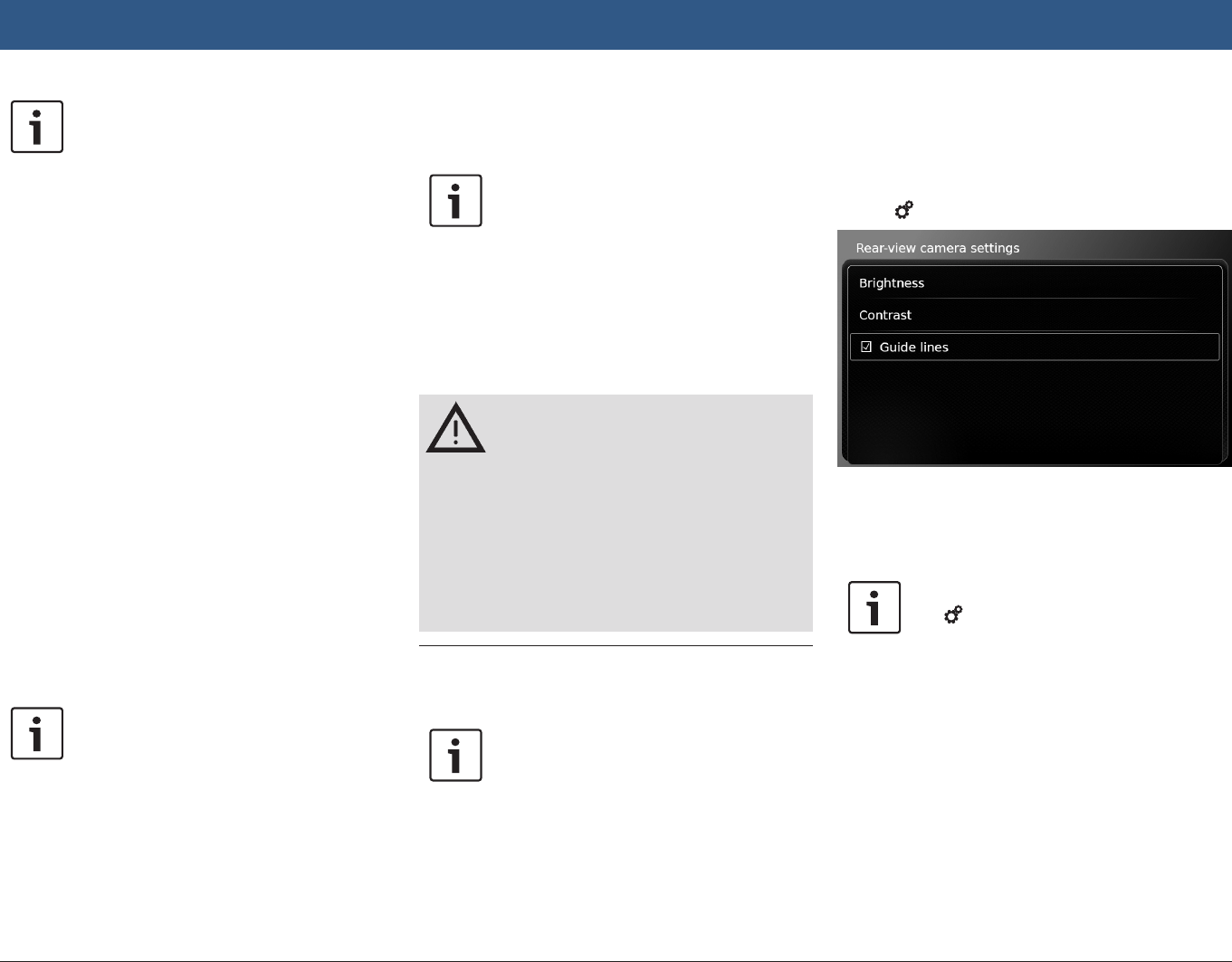
en | 63
Notes:
fAndroid connection priority only
applies if the MirrorLink™ and
Android Auto features are available
on the same smartphone. One
feature, i.e. either MirrorLink™ or
Android Auto, can be chosen at a
time.
fA change to the Android connection
priority setting only takes effect
after the smartphone is discon-
nected.
10.3.2 Enabling the keypad lock
while driving
You can set the keypad lock in the system set-
tings.
If the Lock keypad while driving setting is ena-
bled, you will only be able to access the keypad
while the vehicle is stationary.
For further details on this, please read the sec-
tion entitled “Enabling the keypad lock while
driving” (page 15).
Note:
This function applies to the Apple
CarPlay and Android Auto features but
does not apply to the MirrorLink™
feature.
11 Rear-view camera
Note:
This function is only available if the
vehicle is equipped with a rear view
camera.
The picture from the rear-view camera is auto-
matically shown on the display for as long as the
reverse gear is engaged.
Road safety
When reversing, if you only look at the
picture provided by the rear-view cam-
era, you may fail to notice other road
users or objects outside the picture
and may cause an accident.
Therefore, please always also pay
attention to your vehicle’s surround-
ings.
11.1 Picture settings for the rear-
view camera
Note:
You can only change the settings while
the reverse gear is engaged.
11.1.1 Guide lines – on/off
The superimposed guide lines project the
dimensions of the vehicle onto the section of
road behind.
fTap 6.
fTap Guide lines.
The guide lines are shown when the check mark
is displayed in the checkbox.
Note:
Tap 6 to close the settings.
Smartphone integration | Rear-view camera

64 | en
11.1.2 Adjusting the picture bright-
ness and contrast
fTap 6.
The settings for the rear-view camera are dis-
played.
fTap Brightness or Contrast.
The picture from the rear-view camera is dis-
played.
fTap or to decrease or increase the
value.
Note:
Tap 6 to close the settings or tap
to return to the settings for the
rear-view camera.
The settings are also closed when you
disengage the reverse gear.
12 Voice control
Note:
This feature is only available if the
selected system language supports
voice recognition. To select a system
language, please read the section
entitled “Setting the language”
(page 20).
Important note:
Please understand that voice recogni-
tion errors are inherent in the process.
Neither Suzuki nor its suppliers shall
be liable for any damages arising out of
errors in the voice recognition process.
Voice recognition performance
depends on the user’s pronunciation
and accent.
Using the voice control feature, you can select
many of the device’s functions by means of
spoken commands.
Voice control is available for the following oper-
ating modes:
fTelephone
fNavigation
fPlaying media (audio)
Note:
When voice control is active, the cur-
rently available voice commands are
shown on the display. To ensure the
device correctly recognises your com-
mand, please say the command as it is
shown in the display.
The device can, however, also recog-
nise other corresponding commands
(e.g. “satnav” instead of “navigation”).
12.1 Voice control – start/stop
To start voice control,
ftap 5.
To stop voice control,
fsay “Cancel”.
Note:
To stop voice control, you can also
tap 4.
Rear-view camera | Voice control